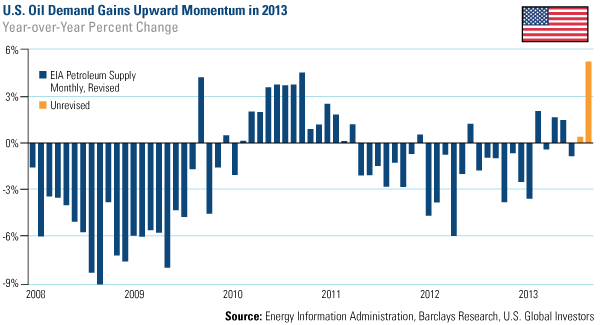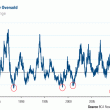Energy and Natural Resources Market
Strengths
- Manufacturing PMIs, a good indicator of manufacturing output growth, signaled expansion across the developed economies in July with a rampant U.S. and recovering Europe. Data complied by Macquarie shows the G3 PMI, a weighted-average of the US, Europe and Japanese PMIs, rose to 52.1 in July, from 50.1 in June and marking its highest level since June 2011. All three regions recorded a figure above 50, denoting expansion, the first time this has happened since July 2011. This should be good for commodity demand. However, China remains a risk, where more bullish official data is contradicted by a more bearish private survey, and other key developing regions were weak.
- Crude oil (West Texas Immediate) gained more than $2 per barrel following stronger than expected PMI data. Copper also gained on the week following stronger than expected PMI data.
Weaknesses
- Stocks of fertilizer miners plunged this week on news that prices of potash fertilizer may fall sharply following the breakdown of the main potash producer cartel that controlled approximately 40 percent of global exports.
- Uranium prices are showing little sign of recovery after sinking to the lowest in more than seven years amid a glut of the radioactive metal and speculation Japan will delay restarting its nuclear reactors. “The process for restarts is clearly going to take some time,” said Jonathan Hinze, a senior vice president at Roswell, Georgia-based Ux, which provides research on the nuclear industry. “Japanese utilities are unlikely to require any new fuel until 2014 at the earliest. There is a realization that the uranium demand from Japan is unlikely to dramatically change anytime soon, especially this year.” Uranium for immediate delivery has dropped as much as 21 percent this year, extending a 17 percent decline in 2012, according to data from Ux. Prices slumped 12 percent in July, the biggest monthly loss since March 2011. They climbed as high as $152 in June 2007.
- Chinese net imports of thermal coal (including anthracite and lignite) declined in June both versus the previous month and last year, and were the lowest of the year at 17.2mt, making for a first half 2013 growth rate of 12 percent year-over-year. If realized over the remainder of the year, this would be lowest annualized growth rate (12 percent) in the five years since China began importing thermal coal on a net basis, and 2013 net imports would be 240mt, below our current estimate of 249mt.
- Corn fell to the lowest level in more than 33 months as cool, wet weather boosted the outlook for a record crop in the U.S., the world’s biggest grower. Corn plunged 32 percent this year as the U.S. government expects the domestic harvest to jump to 13.95 billion bushels, up from a six-year low of 10.78 billion bushels a year earlier, when the worst drought since the 1930s damaged fields.
Opportunities
- China plans to cut steel capacity from the 400 million metric tons of production that was built without proper approvals, the National Business Daily reported, citing an unidentified person. Authorities will stop banks from lending to steelmakers with unapproved capacity if the companies have failed to meet environmental and land use rules, the newspaper said. The 400 million tons of unapproved capacity accounts for more than 40 percent of China’s total, according to the report. Unapproved capacity operating within China’s environmental and land use standards may continue to be supported by banks because of considerations for local employment and tax revenue, the newspaper reported.
- Copper investment may win future preference over other products “because we see that in the long term it could have greater returns,” BHP Billiton CEO Andrew Mackenzie said in interview with Chilean newspaper El Mercurio. Copper is “fundamental part” of the company’s future strategy, along with iron, coal and oil, he said. While Copper prices may rise 3 percent per year in the long term, we have to prepare for a copper price like the current one or perhaps a little lower, that is, around $3 a pound, according to Mackenzie. Chile’s market leadership in copper at risk unless the nation makes productivity improvements, Mackenzie said in the interview.
Threats
- World copper supply may outstrip demand by 643,000 metric tons in 2014, the highest since 2009, compared with 143,000 tons this year as mine output increases amid slowing demand from China, Yoshihiro Nishiyama, Senior Executive Officer in the marketing department at Pan Pacific Copper said. China’s consumption will decline 2.5 percent next year, he said. New and expanding mine output including Oyu Tolgoi in Mongolia, Kamoto and Kov mines in the DRC and Caserones, Collahuasi and Escondida in Chile, will add 742,000 tons in 2013 and 990,000 tons in 2014, Nishiyama said. World production of refined copper will increase 7 percent to 21.9 million tons in 2014 from 2013, while demand will grow 4.5 percent to 21.3 million tons, Nishiyama said.
















